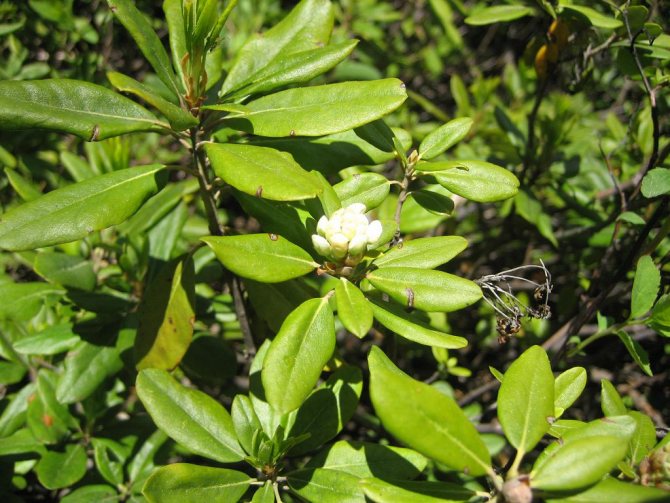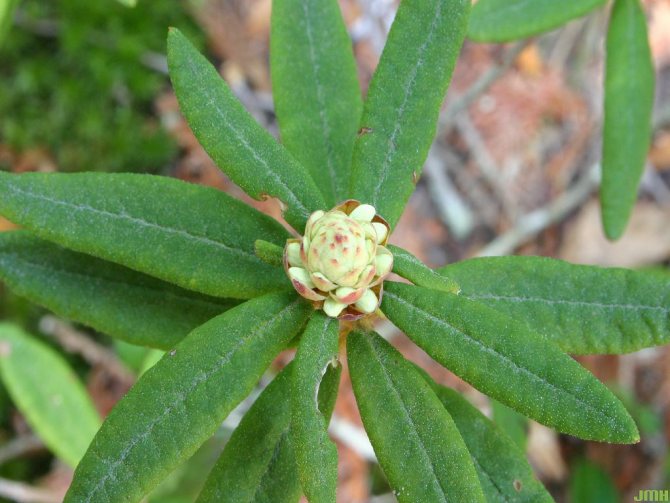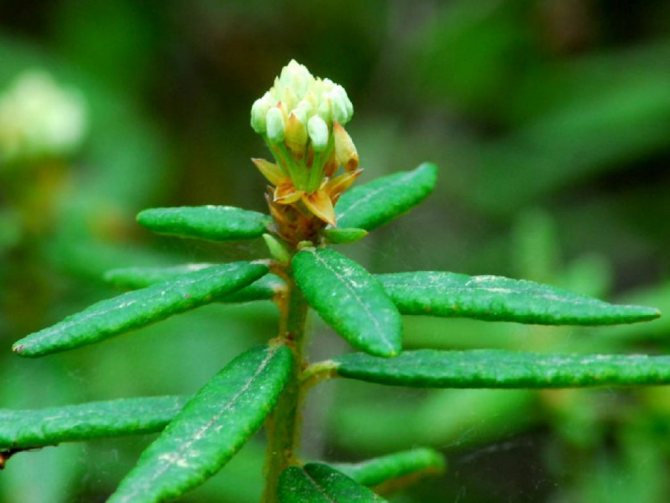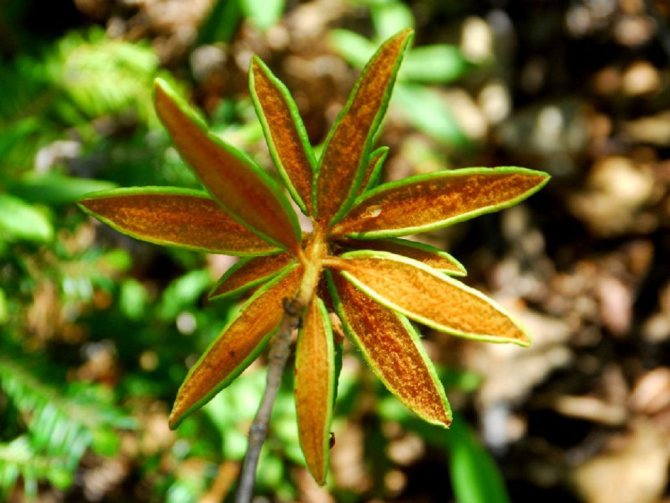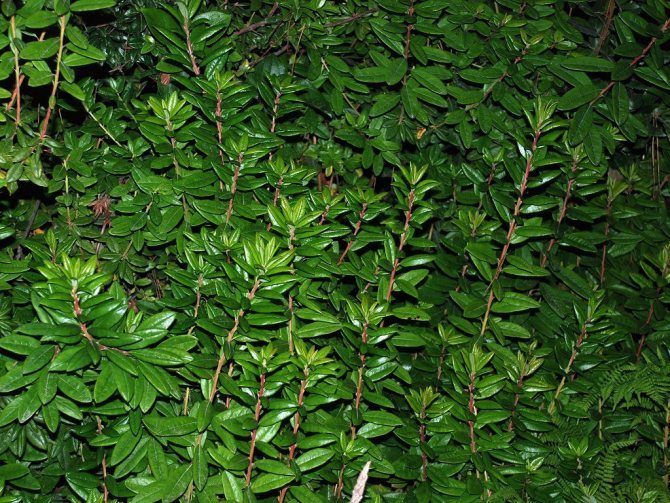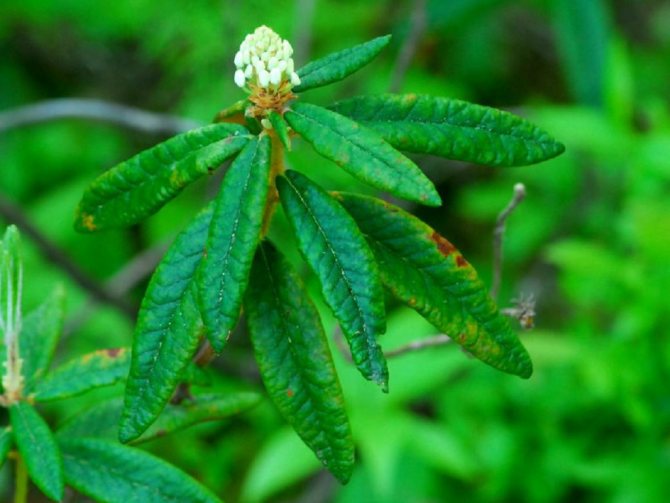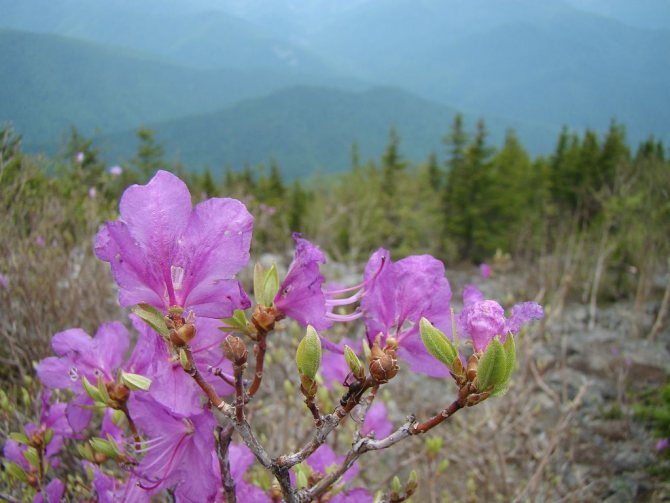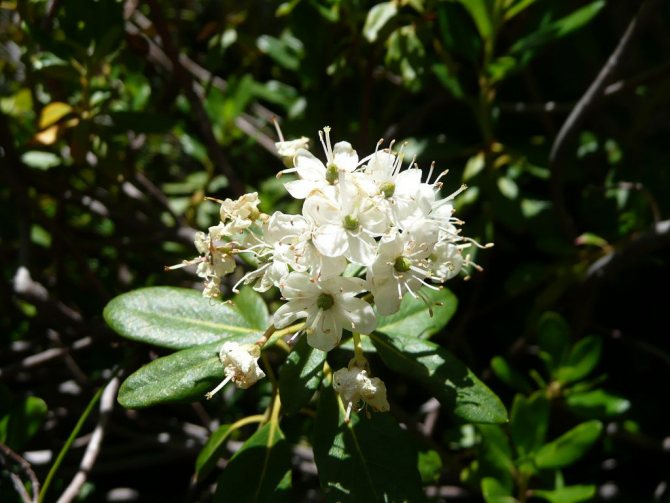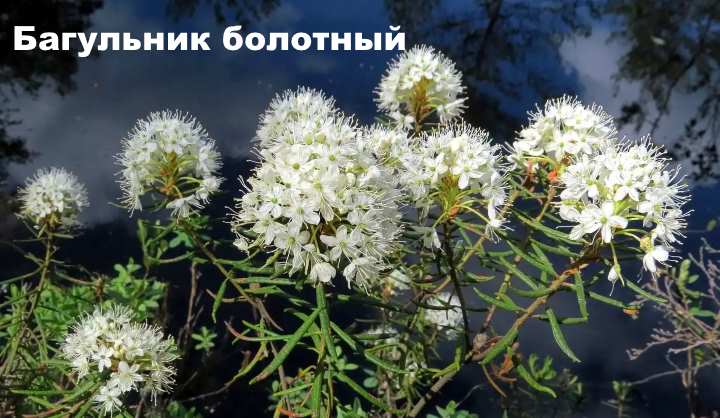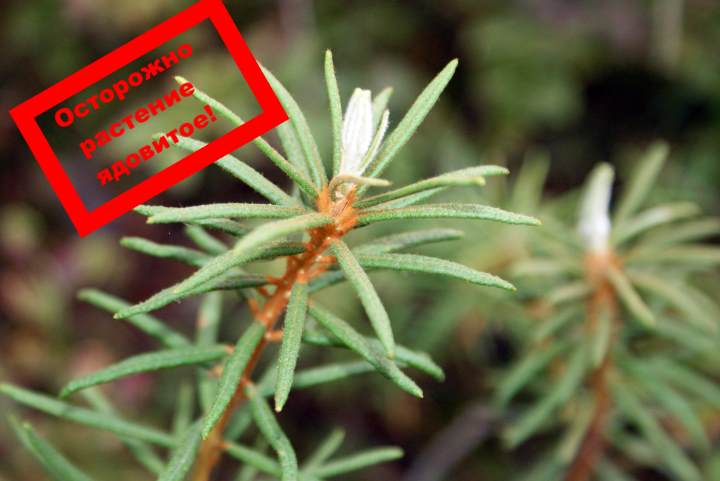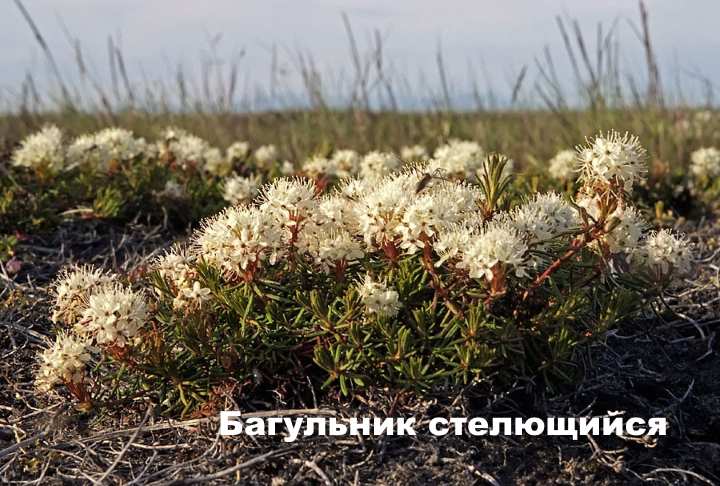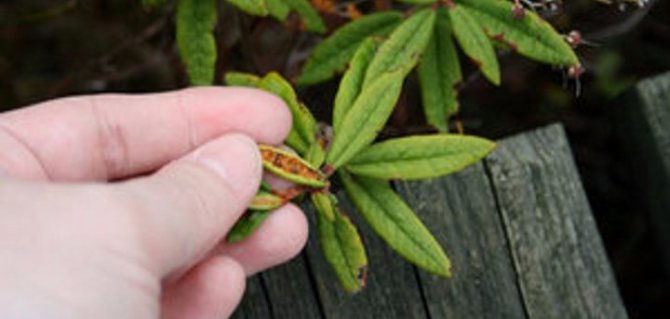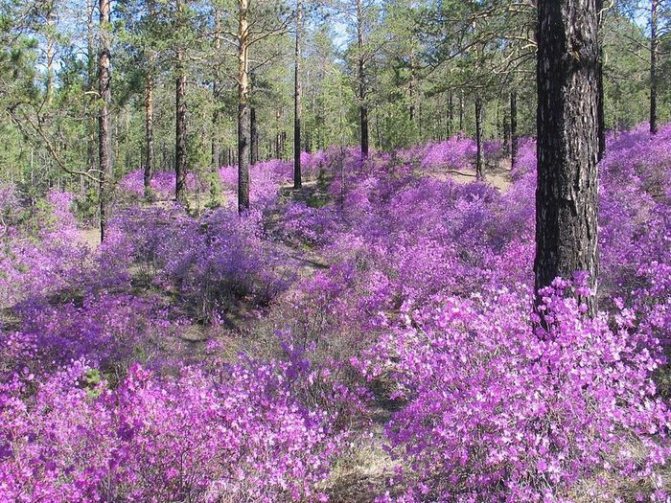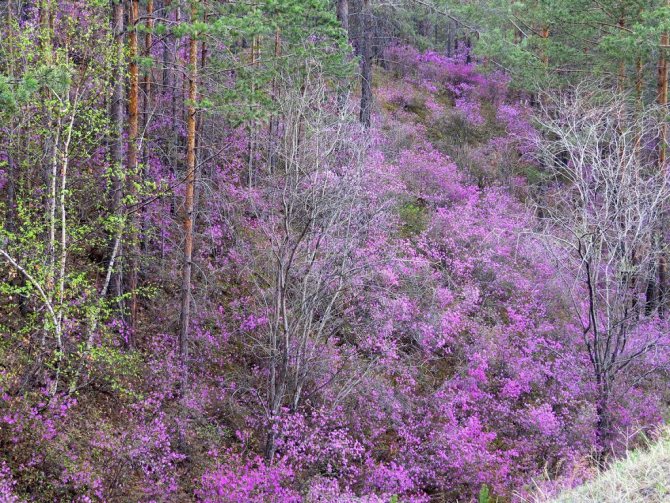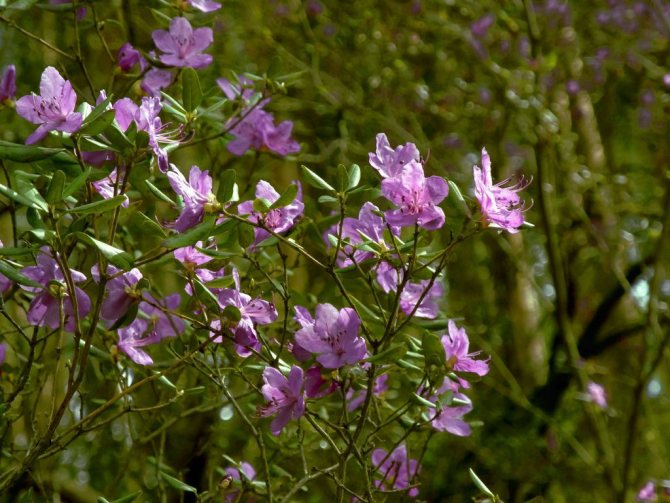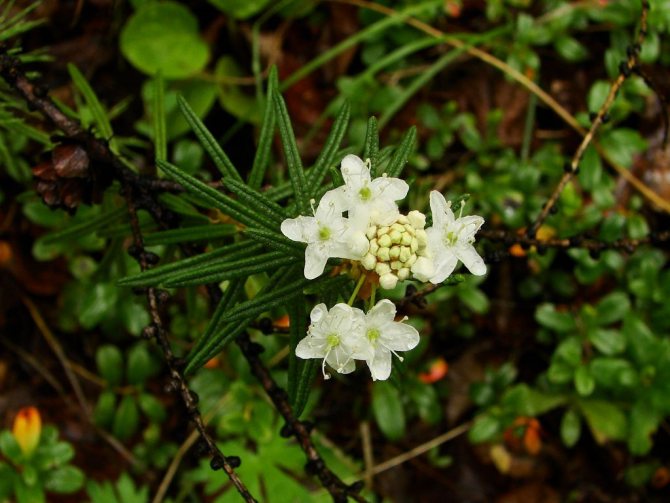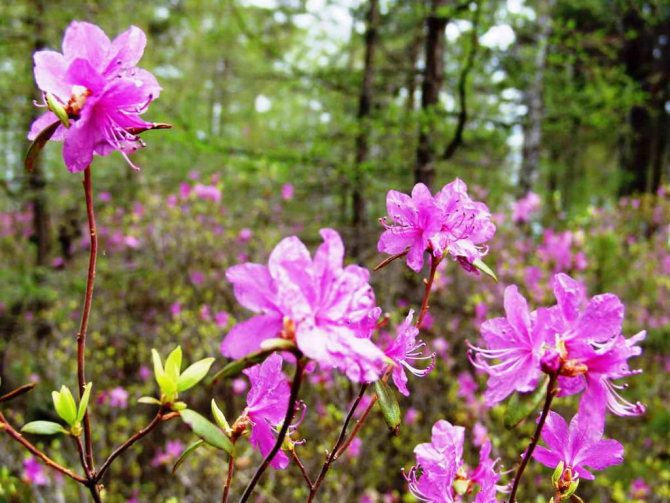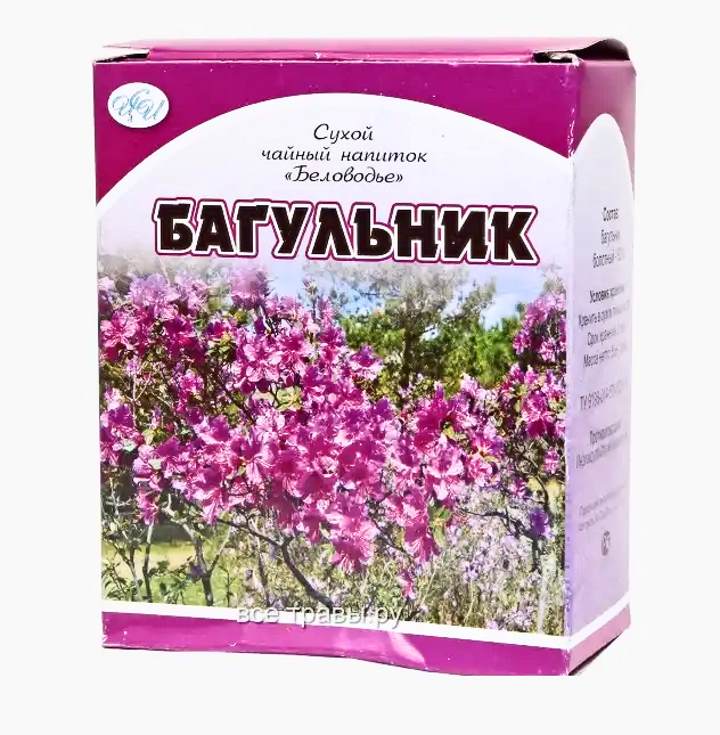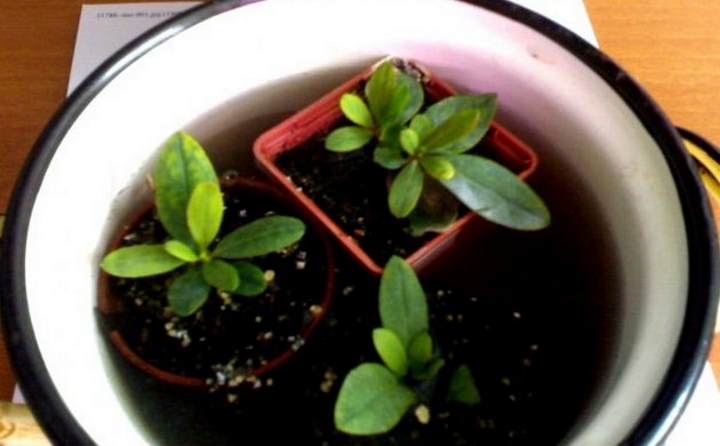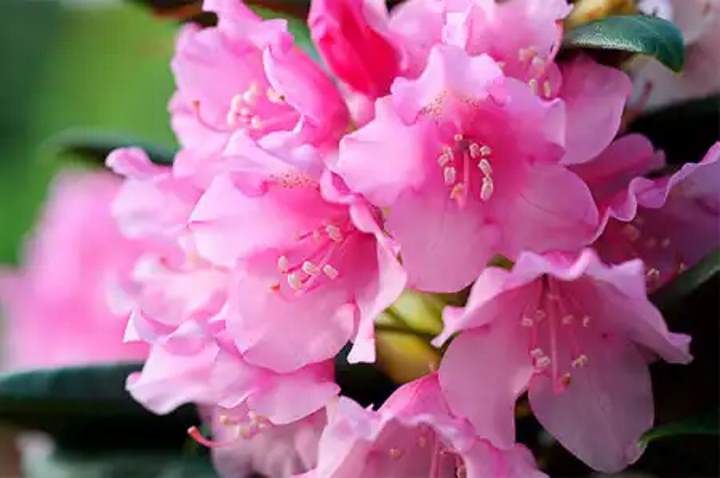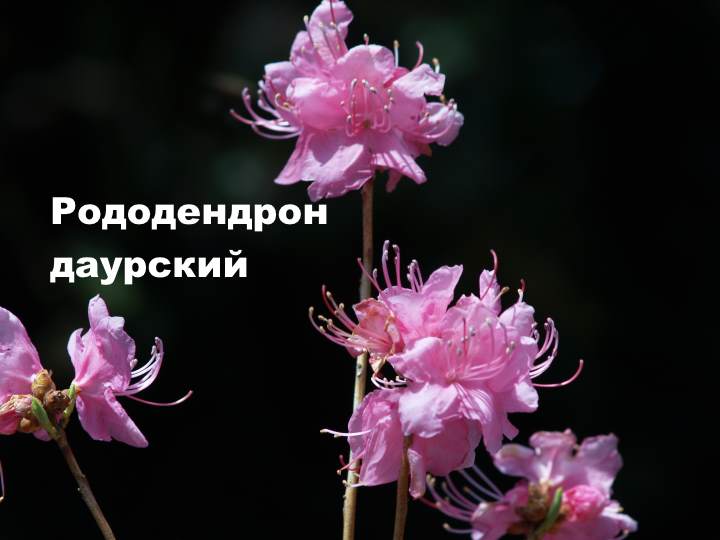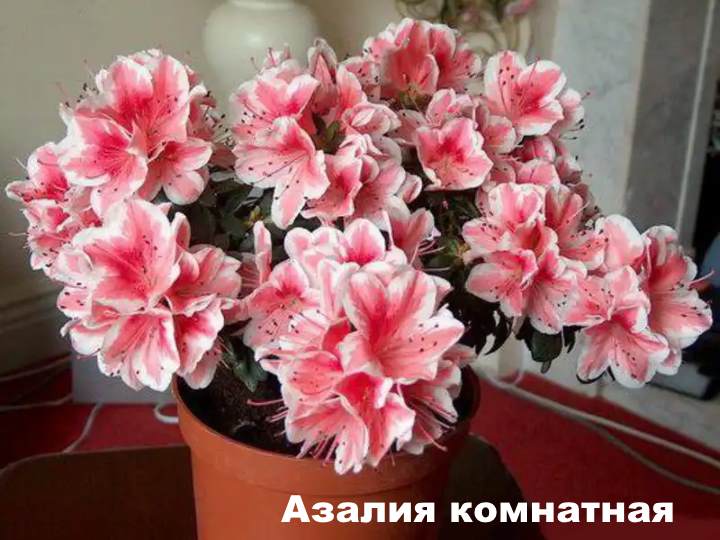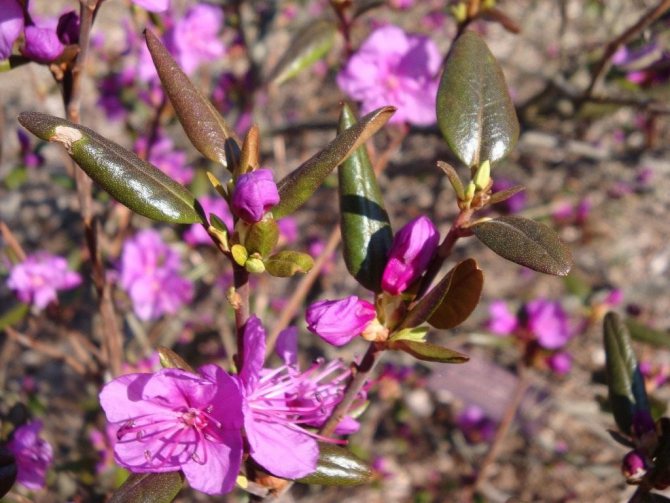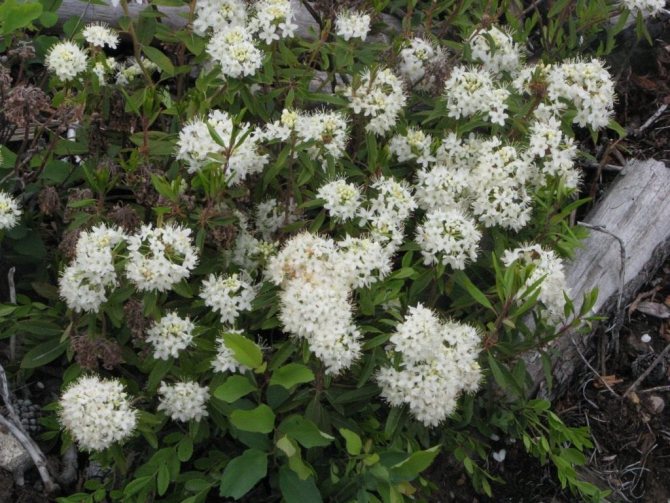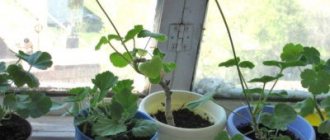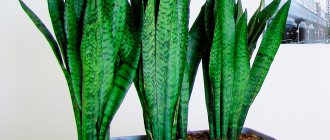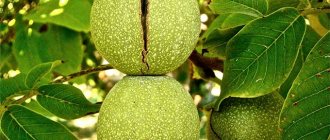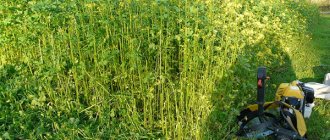Ledum is an evergreen shrub from the Heather family. The scientific name - ledum - brings it closer to incense, as the dense leaves also exude an intense woody scent. The word "wild rosemary" is translated from the Old Russian language as intoxicating, poisonous, intoxicating. Sometimes the plant is called oregano, hemlock, wild rosemary, goddess. Its habitat is quite wide. It affects the Northern Hemisphere, in particular the temperate subarctic belt. Ledum is very often used for medicinal purposes, but can also be used to decorate the garden.
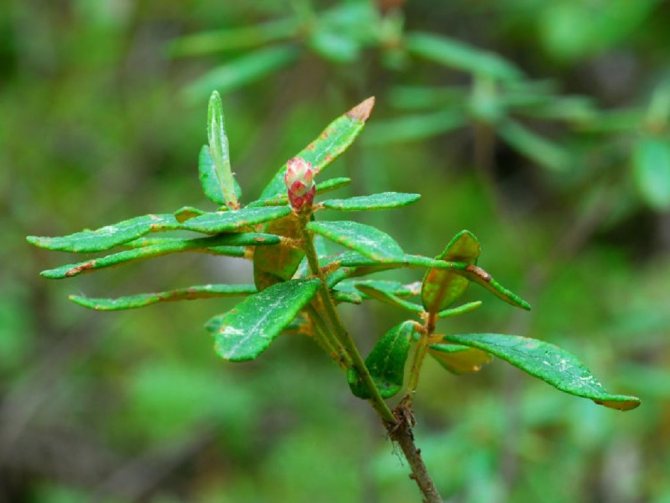
Plant appearance
Ledum is a perennial shrub or shrub 50-120 cm high. It is fed by a branched surface rhizome with short shoots. Rigid branched stems do not differ in large diameter. They can be erect, ascending, or creeping. Olive green young shoots are covered with rusty pubescence, but over time they are covered with bare dark bark.
Leathery short-petiolized foliage persists throughout the year. It has an elongated or lanceolate shape with a raised central vein and edges curled downwards. The color of the leaves is dark green. It turns brownish brown in bright light. Leathery leaves grow next. When rubbed, they give off a sharp intoxicating smell.
In April-June, dense umbellate inflorescences bloom on the shoots of last year. Each flower has a short pedicel. White oval petals form a bell-shaped cup. The number of all elements of the flower is a multiple of 5. The wild rosemary is pollinated by insects, after which dry seed pods with 5 sections ripen. Small winged seeds huddle in them.
Attention! All parts of the rosemary are poisonous! After contact with the plant, be sure to wash your hands. Even just being near the thickets and breathing in the aroma, you can soon feel dizzy and weak. Although wild rosemary is a good honey plant, its pollen and honey are poisonous. You can try the product only after prolonged heat treatment and in small quantities.
Oil, ointment
Outwardly, an ointment on animal fats, a decoction in vegetable oil is used for skin diseases: eczema, scabies, insect bites, bruises and frostbite; drops - for rhinitis, flu. Flowers steamed in vegetable oil - as a strong pain reliever for hematomas, bruises, gout, arthritis, and skin diseases.
Decoction in vegetable oil: mix 2 tablespoons of chopped wild rosemary herb with 5 tablespoons of linseed, olive or sunflower oil, leave for 12 hours in a closed vessel on a hot stove, drain.
- Use as an external remedy for rheumatism and skin diseases.
- In case of a runny nose, instill 1-2 drops in each nostril.
- Rub into scalp to remove nits and lice.
Ointment on animal fats: warm the ointment base in a water bath, mix part of the base thoroughly in a porcelain mortar with a pestle with the powder of a medicinal plant, then add the rest of the base. For the preparation of the ointment, usually 10–25% of plant materials from the total volume are used. Store the ointment in a cool, dark place.
Ointments based on animal fats are perishable and cannot be stored for a long time.
Types of wild rosemary
The genus of wild rosemary has only 6 plant species. 4 of them grow on the territory of Russia.
Marsh Ledum. A typical representative of the genus, common in temperate climates. It is a dense bush up to 1.2 m high. Raised branchy shoots are covered with rusty short hair. The dark green glossy leaves exude a pleasant scent. At the end of spring, dense umbrellas or shields with white or light pink small flowers bloom.
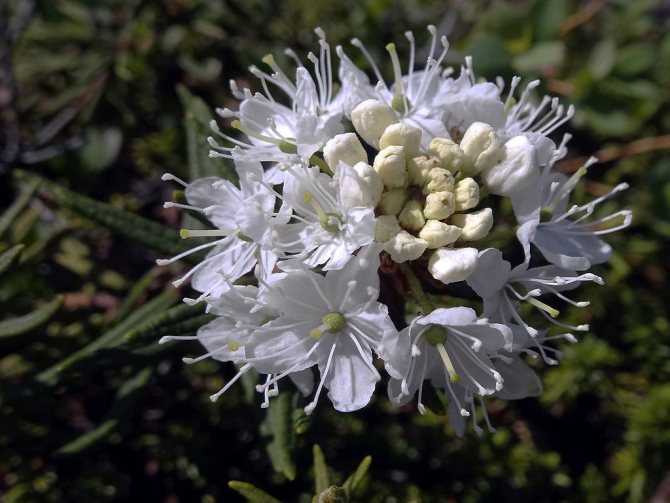

Marsh wild rosemary
Greenland wild rosemary. Rigid lodging stems grow up to 90 cm in length. They are light brown in color. On the shoots, narrow linear leaves are located close to each other, like bright green soft needles. Felt pile is present on the reverse side of the twisted leaves. During the flowering period, small (up to 6 cm wide) umbrellas with white or cream flowers bloom. The view perfectly tolerates even severe frosts.
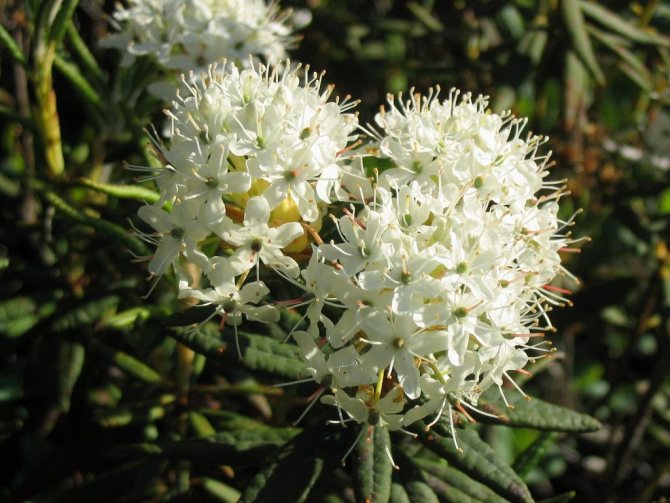

Ledum greenland
Large-leaved wild rosemary. The inhabitant of the Far East, Japan and Korea grows 40-80 cm in height. It settles on rocky embankments and mountain slopes. Oval foliage is 3-4 cm long and 8-15 mm wide. On young shoots and the reverse side of the leaves, there is a thick red pile.
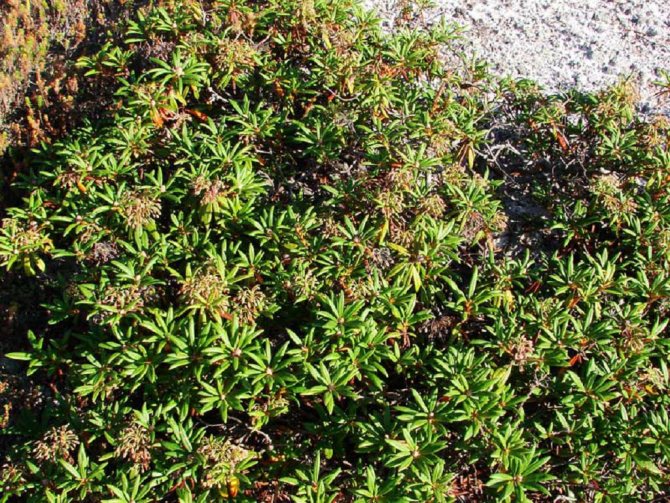

Large-leaved wild rosemary
A few years ago, rhododendron was a synonym for wild rosemary. Until now, some growers attribute Transbaikalian wild rosemary to this genus, but in fact it is only a distant relative and has the scientific name "Daurian rhododendron". The plant is also a highly branched bush 50-200 cm in height. The branches are covered with narrow dense leaves of a dark green color. But the flowers have a rich pink hue. Often this very "rosemary" can be seen in a vase in a bouquet arrangement.
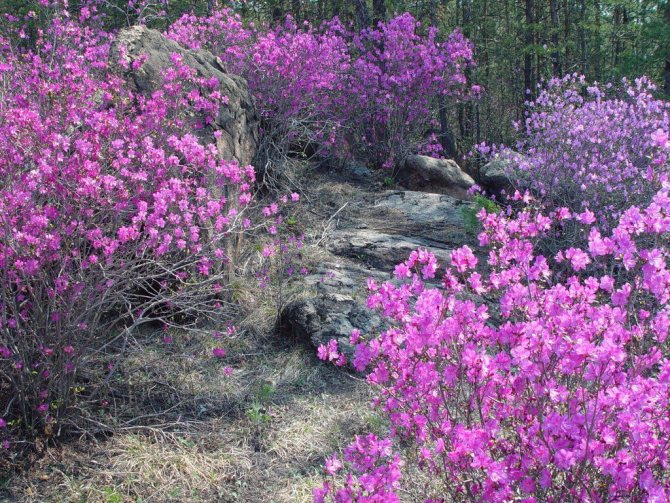

Ledum transbaikalian
Fees
- Marsh rosemary, grass - 5 parts; St. John's wort, grass - 5 parts; pine, buds - 5 parts; field horsetail, grass - 4 parts; mint, herb - 3 parts. Pour 2 tablespoons of the collection with 500 ml of boiling water, leave overnight. Take 1/4 cup 4-5 times a day before meals for cystitis, pyelitis, urethritis. The course of treatment is up to two months.
- Marsh rosemary, grass - 70 g; stinging nettle, leaves - 30 g. 2 tablespoons of dry chopped collection pour 500 ml of boiling water, leave for 30-40 minutes, strain and drink 1 / 3-1 / 2 cup 4-5 times a day for colds, bronchial asthma, cough , rheumatism, etc.
- Marsh rosemary, grass - 20 g; stinging nettle, leaves - 15 g. Pour 1 liter of boiling water and leave for 8 hours in a closed vessel, drain. Take 1/2 cup 4 times a day after meals. For children with whooping cough, give 1 teaspoon 3 times a day.
- Marsh rosemary, grass - 30; marshmallow, roots - 70. 2 tablespoons of dry chopped collection pour 500 ml of cold boiled water, stand for 30-40 minutes, then warm in a boiling water bath for 15 minutes, strain and drink 1/4 cup 6 times a day for gastrointestinal intestinal disorders, dysentery.
- Marsh rosemary, grass - 10 g; marshmallow medicinal, roots - 25 g. Pour the mixture into 1 liter of boiling water, leave for 1 hour. Then strain and drink 1/3 cup 3 times a day after meals for a week with indigestion and dysentery.
- Marsh rosemary, grass - 20; marshmallow medicinal, roots - 40; coltsfoot, leaves - 40. 2 tablespoons of dry chopped collection pour 500 ml of cold boiled water, stand for 30-40 minutes, then warm in a boiling water bath for 15 minutes, strain and drink 1/2 cup for colds, diseases lungs and bronchi.
- Marsh rosemary, grass - 10 g; coltsfoot, leaves - 10 g; violet - 10 g; plantain - 10 g; chamomile - 10 g; anise ordinary - 10 g. Mix and grind everything. Pour 2 liters of boiling water, leave for 8 hours in a warm place, drain. Take 1/3 cup 3 times a day for tracheobronchitis and bronchospasm.
- Marsh rosemary, grass - 20; coltsfoot, leaves - 20. A tablespoon of the mixture is poured with 200 ml of hot water, boiled for 5 minutes, then filtered. Take a tablespoon every 2 hours.
Herbalist B
Ledum is an evergreen shrub from the Heather family.The scientific name - ledum - brings it closer to incense, as the dense leaves also exude an intense woody scent. The word "wild rosemary" is translated from the Old Russian language as intoxicating, poisonous, intoxicating. Sometimes the plant is called oregano, hemlock, wild rosemary, goddess. Its habitat is quite wide. It affects the Northern Hemisphere, in particular the temperate subarctic belt. Ledum is very often used for medicinal purposes, but can also be used to decorate the garden.


Reproduction methods
Ledum breeds excellently by seed and vegetative methods. In nature, new plants are more likely to emerge from seeds. They are collected from matured small bolls, which independently crack from bottom to top. From a distance, achenes resemble tiny chandeliers. Seeds are harvested in autumn, but sown only in early spring. For this, containers are prepared with loose garden soil mixed with sand. The soil should be loose and moist, and also have an acidic reaction. The seeds are spread on the surface and only slightly pressed into the soil. The container is covered with transparent material and placed in a cool place. The greenhouse is periodically ventilated and watered. Seedlings appear in 25-30 days. The grown seedlings are seated in separate peat pots or in another box with a greater distance so that the roots do not get tangled.
It is convenient to propagate garden plants by layering. To do this, flexible branches are tilted to the soil and fixed in a hole with a depth of 20 cm. The top must be left on the surface. After rooting, the shoot is separated.


During the spring transplant, a large bush can be divided into several parts. To do this, the plant is completely dug up, freed from the ground and cut into divisions. Places of cuts are processed with crushed charcoal. The roots do not dry out and immediately determine the seedlings to a permanent place.
For grafting, semi-lignified shoots with 2-3 leaves are cut during the summer. The lower cut is treated with growth stimulants and shoots are rooted in pots with loose and nutritious soil. The leaves closest to the soil are cut off completely or the leaf plate is shortened. Rooting and adaptation takes a long period, therefore, seedlings are transferred to open ground only next spring.
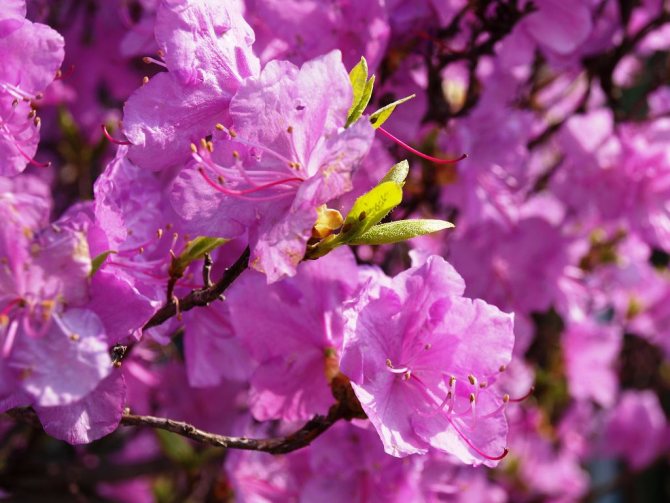

Planting and leaving
Ledum belongs to unpretentious plants, so it does not cause much trouble to the owners. Planting is best done in spring, although this is not necessary for plants with closed rhizomes. Since the roots are located close to the surface of the earth, the planting hole is dug 40-60 cm deep. River sand or pebbles 5-8 cm thick are poured at the bottom. The soil itself should be sufficiently acidic and loose. It is advisable to plant bushes on wet soils with the addition of needles. If several plants are planted at once, the distance between them is 60-70 cm. After all the work is completed, the soil is tamped and watered abundantly. Then the ground near the bushes is mulched with peat.
In its natural environment, wild rosemary grows near water bodies, so regular watering is of great importance. Irrigation is not needed only with frequent precipitation. Lighting for plants is not very important. They feel equally good in a sunny place and in partial shade. Even with strong shading, wild rosemary will not die, but it may look less decorative and bloom less often.


From time to time, the soil should be loosened and weeds removed. However, do not forget that the roots are located close to the surface, so be careful. Several times a season (in spring and summer) wild rosemary is fertilized with mineral complexes. Pruning is carried out in March and October. The sprouts that break out of the given shape are shortened, as well as dry and damaged branches are removed.
Winters are not terrible for wild rosemary. It perfectly tolerates even severe frosts, however, in the absence of snow, the young growth can freeze to the height of the snow cover.In the spring, it is enough to remove the affected branches and young growth will quickly take their place.
Ledum is resistant to plant diseases. He is not afraid of soil flooding, but only with regular loosening. Without air access, the fungus can still develop. Very rarely, bugs and spider mites settle on the shoots. They are easy to get rid of with insecticides. More often, the plant itself scares off annoying insects, including from neighbors in the flower bed.
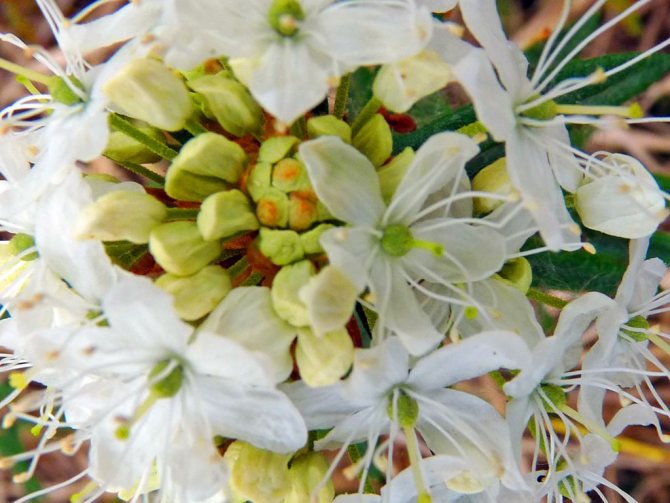

Use in the garden
The dense crown with narrow dark green leaves and reddish pubescence looks very decorative in the garden. Ledum is suitable for landscaping wet soils, the banks of reservoirs and rivers, rocky embankments, as well as spaces under trees. Plants look best in group plantings. Often belt plantings are used as a hedge or for zoning a site. The wild rosemary can be accompanied by heather, cranberry, blueberry, rhododendron, gaulteria, stachis and cereals.
Pharmacological appointment
In alternative medical practice, the plant has been used for many centuries. On the territory of the Russian Federation, the healing properties of the shrub became known in the 17th century. Folk aesculapians wrote a whole book with effective recipes called "All about the benefits of stinking heather." Interest in wild rosemary does not fade away, clinical studies have been carried out repeatedly, proving the bactericidal and anti-inflammatory properties of marsh grass.
Decoctions with infusions (confirmed by practice) help with bronchopulmonary diseases. They promote expectoration, liquefaction of phlegm, and the removal of the inflammatory process. In terms of therapeutic power, wild rosemary can easily compete with many medicinal herbs. It is prescribed even for tuberculosis, whooping cough, gout and rheumatoid pathologies.


Since ancient times, herbal decoction has been used to treat heart failure, diseases of internal organs (kidneys, liver), and hypertensive crisis. It has established itself well as an antihistamine. Infusions were used to solder children and adults suffering from helminthic invasion. The remedy is widely used by homeopaths during a cold epidemic to strengthen the defenses.
The ground parts have a mild sedative, disinfectant, wound healing and hypnotic effect. The brewed leaves are used to wash the sinuses, apply compresses for skin lesions. Used for frostbite, swelling, dermatological diseases, to improve blood flow in the extremities (baths, lotions).
Beneficial features
Leaves and flowers of wild rosemary contain many biologically active substances recognized not only by folk, but also by official medicine. Among them:
- essential oils;
- tannins;
- flavonoids;
- ascorbic acid;
- gum;
- phytoncides.
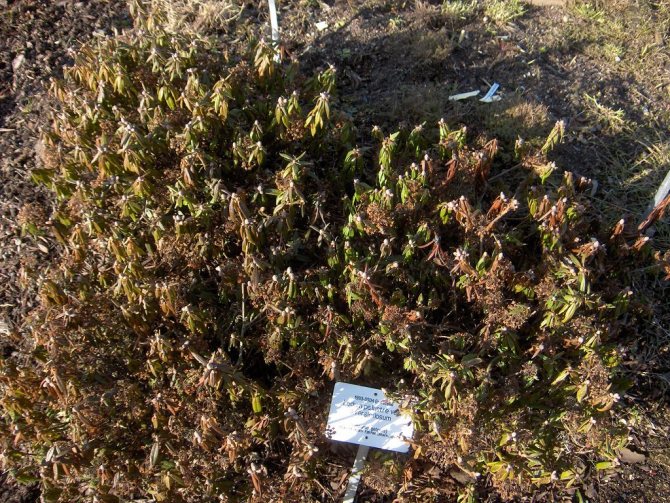

Since ancient times, the broth has been used as an antiseptic and antibacterial agent. It was used externally, added to baths or compresses, and also drank to fight coughs, SARS and intestinal infections.
Tea with rosemary leaves soothes and fights insomnia. The plant copes well with diseases such as pneumonia, whooping cough, bronchitis, liver and kidney disease, gastritis, eczema, boils, chickenpox, cholecystitis. Drugs are also useful for women's health. They strengthen muscles and fight sexually transmitted diseases. Moreover, in different countries, the "specialization" of wild rosemary may differ.
They have plants and household purposes. The smell of foliage scares off blood-sucking insects and moths.
Ledum is contraindicated for people suffering from allergies and sensitive to plant components. Since it increases the tone of the uterus, the treatment is unacceptable for pregnant women. And of course, the dosage should not be exceeded, so it is better to carry out treatment under the supervision of a doctor.
Infusion
Infusion inside - as an antitussive and bactericidal in acute and chronic bronchitis, pneumonia, tuberculosis, whooping cough and other diseases accompanied by cough. With spastic enterocolitis, endometritis, jaundice, liver diseases, cholecystitis, shortness of breath, asthma, oliguria, diathesis, eczema, gummazy ulcers, tuberculous lymphadenitis, urethritis and as an abortive agent, with angina pectoris and various forms of rheumatism. For insomnia and as a means to dilate blood vessels, improve circulation and moderately lower blood pressure. The infusion is added to wine for alcoholism.
Infusion externally - for hair growth, for gout, arthritis, skin diseases, wounds, frostbite, in the treatment of tumors; in the form of baths, lotions and poultices - for various gynecological diseases, diathesis, hematomas, bruises, wounds, snake bites, poisonous insects, dermatomycosis, chickenpox, blepharitis, conjunctivitis.
For infusion, the daily dose is 1 tablespoon of dry, chopped herbs. In case of an overdose, headache, dizziness, agitation and irritability are possible, followed by depression of the nervous system.
- Pour a teaspoon of wild rosemary herb with two glasses of boiling water, leave for 30 minutes and take 1 tablespoon 4 times a day to gently lower blood pressure.
- Two tablespoons of dry chopped wild rosemary herb pour 500 ml of boiling water. Insist in a thermos for 30 minutes, strain and take 1/3 cup 3 times a day 30 minutes before meals.
- Insist a teaspoon of wild rosemary herb for 8 hours in 2 glasses of cooled boiled water in a closed vessel, drain. Take 1/2 cup 4 times a day.
- Two tablespoons of dry crushed rosemary herb are placed in an enamel bowl, pour 200 ml (1 glass) of hot boiled water, cover with a lid and heat in a water bath for 15 minutes, cool for 45 minutes at room temperature, squeeze the remaining raw materials. The volume of the resulting infusion is brought to 200 ml with boiled water. It is taken warm, 1/4 cup 2-3 times a day after meals as an expectorant and bactericidal agent for chronic bronchitis and other lung diseases, accompanied by cough. The prepared infusion is stored in a cool place for no more than 2 days.
- Brew two tablespoons of wild rosemary with a glass of boiling water. Insist. Take 1/4 cup 2-3 times a day after meals for the treatment of bronchitis and bronchial asthma. For whooping cough, give children 1 teaspoon 3 times a day.
- Brew 15 g of dry wild rosemary with a glass of boiling water, leave for 30 minutes, drain. Wet sterile napkins in warm infusion and put on eyes. The same infusion can be used to treat skin diseases, inhalation and gargle.
Signs and superstitions
The wild rosemary herb is shrouded in a large number of legends, it will also take superstitions, so many doubt whether it is worth keeping it in the house. Although some are wary of wild rosemary, it is very useful, prevents the spread of pathogenic microbes in the air and heals the body. Of course, if you leave a lot of flowering branches in a small room, the household will be haunted by a headache. Hence the omen that wild rosemary increases nervousness, irritability and brings troubles. But a couple of sprouts won't hurt at all. On the contrary, they will cleanse the atmosphere of negative energy and fill the room with a pleasant, unobtrusive aroma.





